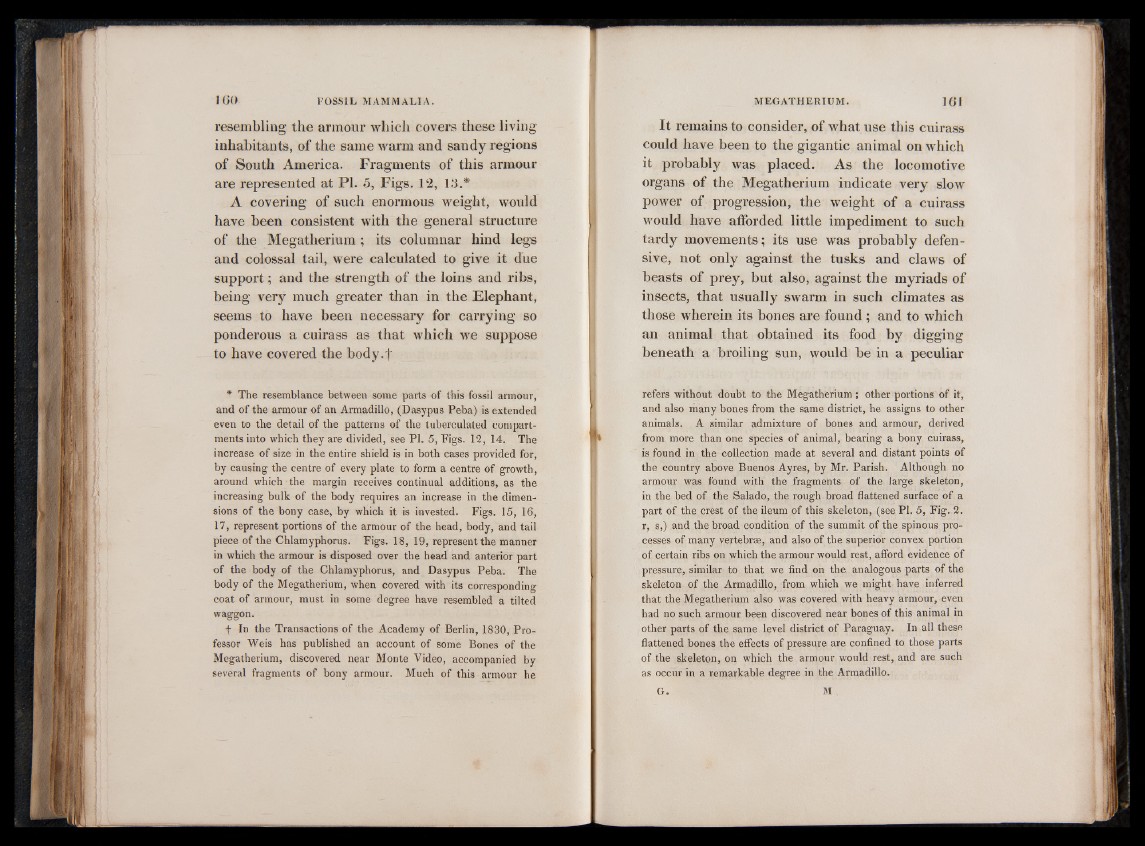
resembling the armour which covers these living
inhabitants, of the same warm and sandy regions
of South America. Fragments of this armour
are represented at PI. 5, Figs. 1 2 , 13.*
A covering of such enormous weight, would
have been consistent with the general structure
of the Megatherium; its columnar hind legs
and colossal tail, were calculated to give it due
support; and the strength of the loins and ribs,
being very much greater than in the Elephant,
seems to have been necessary for carrying so
ponderous a cuirass as that which we suppose
to have covered the body.f
* The resemblance between some parts of this fossil armour,
and of the armour of an Armadillo, (Dasypus Peba) is extended
even to the detail of the patterns of the tuberculated compartments
into which they are divided, see PI. 5, Figs. 12, 14. The
increase of size in the entire shield is in both cases provided for,
by causing the centre of every plate to form a centre of growth,
around which the margin receives continual additions, as the
increasing bulk of the body requires an increase in the dimensions
of the bony case, by which it is invested. Figs. 15, 16,
17, represent portions of the armour of the head, body, and tail
piece of the Chlamyphorus. Figs. 18, 19, represent the manner
in which the armour is disposed over the head and anterior part
o f the body of the Chlamyphorus, and Dasypus Peba. The
body of the Megatherium, when covered with its corresponding
coat of armour, must in some degree have resembled a tilted
waggon.
f In the Transactions of the Academy of Berlin, 1830, Professor
Weis has published an account of some Bones of the
Megatherium, discovered near Monte Video, accompanied by
several fragments of bony armour. Much of this armour he
It remains to consider, of what use this cuirass
could have been to the gigantic animal on which
it probably was placed. As the locomotive
organs of the Megatherium indicate very slow
power of progression, the weight of a cuirass
would have afforded little impediment to such
tardy movements; its use was probably defensive,
not only against the tusks and claws of
beasts of prey, but also, against the myriads of
insects, that usually swarm in such climates as
those wherein its bones are found ; and to which
an animal that obtained its food by digging
beneath a broiling sun, would be in a peculiar
refers without doubt to the Megatherium; other portions of it,
and also many bones from the same district, he assigns to other
animals. A similar admixture of bones and armour, derived
from more than one species of animal, bearing a bony cuirass,
is found in the collection made at several and distant points of
the country above Buenos Ayres, by Mr. Parish. Although no
armour was found with the fragments of the large skeleton,
in the bed of the Salado, the rough broad flattened surface of a
part of the crest of the ileum of this skeleton, (see PI. 5, Fig. 2.
r, s,) and the broad condition of the summit of the spinous processes
of many vertebrae, and also of the superior convex portion
of certain ribs on which the armour would rest, afford evidence of
pressure, similar to that we find on the analogous parts of the
skeleton of the Armadillo, from which we might have inferred
that the Megatherium also was covered with heavy armour, even
had no such armour been discovered near bones of this animal in
other parts of the same level district of Paraguay. In all these
flattened bones the effects of pressure are confined to those parts
of the skeleton, on which the armour would rest, and are such
as occur in a remarkable degree in the Armadillo.
G. M